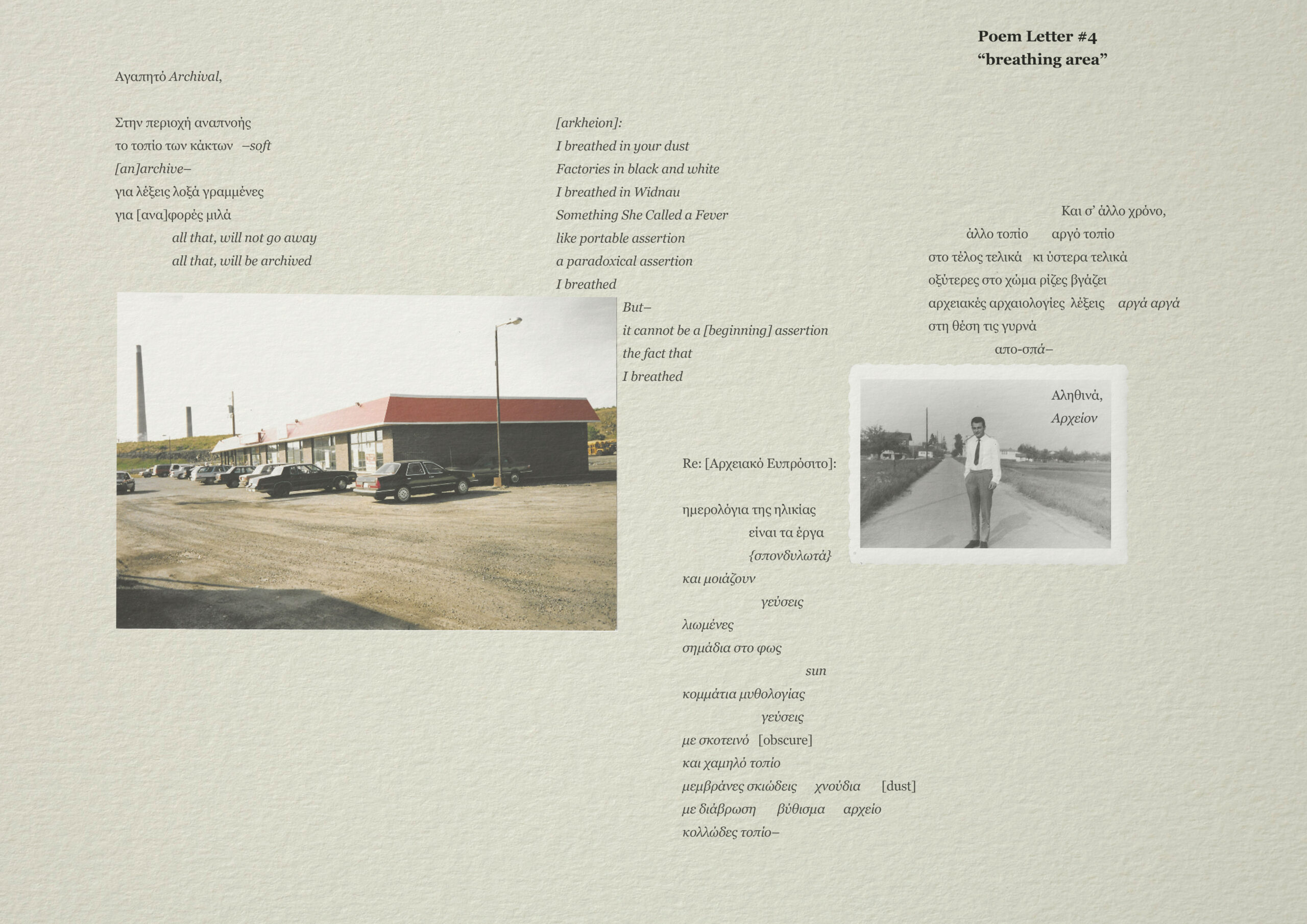breathing area. Poem Letter #4
Ioannis Andronikidis’ series of Poem Letters (#1-4) initiates an ongoing research project around translation as an archival process. A bilingual epistolary and poetic correspondence unfolds onto relief paper surfaces, upon which photographs selected from his personal and family archive (1960s–1980s / 2000 onwards) have been printed. Through different epistolary poetic forms, two fictional characters discuss the notion of “the archive,” autobiography (here, the term “autobiology” is adopted) and thus the body archive of both the interlocutors and, naturally, of the archival material itself.
The research project commences with Jacques Derrida’s “the archive always holds a problem for translation.” While acknowledging “the unstable limit between public and private […] between the family and an intimacy even more private than the family, between oneself and oneself,” it problematises fixed definitions of “problem” and “trouble” –wherein also dis/comfort– and suggests a contingent understanding and interpretation of the textual and the photographic[1].
The aim of the research project is not to designify the archival material (the photographs) by means of the Poem Letters, but to call for a reimagination of the ways we “read” and “tran(re)slate” archival material. Ioannis Andronikidis explores the latter in the space(s) between the nameable and the unnamable, the translatable and the untranslatable, between compulsive and nostalgic repetition, archive and anarchive, between oneself and oneself.
- Jacques Derrida, “Theses.” Archive fever: a Freudian impression. Translated by Eric Prenowitz, Chicago: University of Chicago Press, 1996. ↑

Left: Family business, of Sudbury, Ontario, circa 1980. Original photo, 10 x 15 cm. From the Nikolaos Katsanos’ family archive. In the possession of the author.
Right: Nikolaos Katsanos, of Widnau, Switzerland, circa 1962. Original photo, 6.5 x 9.5 cm. From the Nikolaos Katsanos’ family archive. In the possession of the author.
This contribution is published in the framework of the Whole Life Academy.
Connected Material
Schaber’s contribution revisits her 2004 work culture is our business and considers the complex issues around these three agencies. At stake in these differences are how the image’s story should be told, and how this telling is embedded in the viewing and understanding of history.
Archives are often perceived as somewhat static. They look back, they conserve, they remember. But the thinking that was present in the pieces of the Pinkus Archive all addressed ecology, extinction, and political agency in ways that not only extend into our present, but into our future.
This essay explores the plural notion of “ethnofuturisms” by employing a comparative approach. The cultural and political vicissitudes of “futurist” tropes are traced in literary and audiovisual creations that engage with the national, ethnic, and/or racial contexts of the Middle East, African diaspora, East Asia, and former Eastern Bloc.
Chto Delat’s installation Canary Archives employs the imagery of the canary in the coal mine, once used to alarm miners when carbon monoxide levels rose. Where is the canary today, that tells us wether the danger is real? It seems to have gone silent, the sharpest signal it can send. In an emergency newspaper issue under the impression of the Russian war on Ukraine, Chto Delat assembles anti-war views of artists and critics and expresses their solidarity with the Ukrainian people.
A conversation about KANG Sang-woo’s film KIM-GUN and how it treats historical evidence and testimonies as a ‘horizon of contingent truths’ with the potential to be pieced together in alternating ways, touching upon the complex dynamics of archives and life stories, collective memory and amnesia, the mechanisms of image-making and history-writing.
The legacy of anti-colonial leader and Pan-Africanist revolutionary Amílcar Cabral (1924-1973) still calls for cultural readings, and not strictly political ones. Contemporary art, so-called “artistic research” and critical theory will benefit from a cross-disciplinary approach which puts Cabral as relevant to art or which turns Cabral’s many contributions into tools.
Three videos are used in real time composition to explore the combination of the moving images – the edited sequence creates a non-existing-place.
This video interweaves the mobility of defiance against national-colonial borders and the collection of gossips by Southeast Asian migrants in Berlin.
The video explores the encounter (digital and analogue) between the body and the archive.
The Perverted Archival Image workshop centered on and tentacled off from Studio Baalbeck. The workshop participants created an audio montage of recordings to accompany some of the visual archive material.